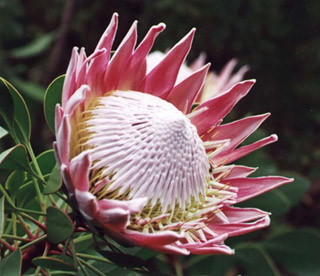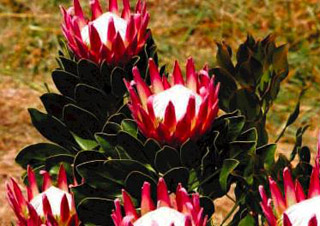Королевская протея


Национальный цветок ЮАР — гигантская, или королевская, протея (Giant or King Protea / Protea cynaroides). Она распространена на юго-западе и на юге Западного Кейпа, от гор Седарберг (Cedarberg) до Грэмстауна. Головка цветка, напоминающая артишок, стала причиной того, что по-латыни его стали называть "cynaroides", что означает "похожий на артишок". Разумеется, такое имя кажется несправедливым по отношению к самой крупной из протей. Можно обнаружить королевскую протею разных цветов и с разной формой листьев, но самая красивая — розовая протея.
Королевская протея стала в 1975 г. национальным цветком Южно-Африканской Республики (ЮАР). В природе существуют несколько цветовых вариаций этой протеи, наиболее эффектная — с серебристо-розовыми прицветниками.
Etymology. The specific epithet cynaroides refers to the artichoke-like appearance of the flower-heads: the artichoke belongs to the genus Cynara.
Protea is both the botanical name and the English common name of a genus of flowering plants, sometimes also called sugarbushes.
The genus Protea was named in 1735 by Carolus Linnaeus after the Greek god Proteus who could change his form at will, because proteas have such different forms.
Proteas attracted the attention of botanists visiting the Cape (South Africa) in the 1600s. Many species were introduced to Europe in the 1700s, enjoying a unique popularlity at the time amongst botanists.
The Proteaceae family to which Proteas belong is an ancient one. Its ancestors grew in Gondwanaland, 300 million years ago. Proteaceae is divided into two subfamilies: the Proteoideae, best represented in southern Africa, and the Grevilleoideae, concentrated in Australia and South America and the other smaller segments of Gondwanaland that are now part of eastern Asia. Africa shares only one genus with Madagascar, whereas South America and Australia share many common genera — this indicates they separated from Africa before they separated from each other.
Королевская протея стала в 1975 г. национальным цветком Южно-Африканской Республики (ЮАР). В природе существуют несколько цветовых вариаций этой протеи, наиболее эффектная — с серебристо-розовыми прицветниками.
Etymology. The specific epithet cynaroides refers to the artichoke-like appearance of the flower-heads: the artichoke belongs to the genus Cynara.
Protea is both the botanical name and the English common name of a genus of flowering plants, sometimes also called sugarbushes.
The genus Protea was named in 1735 by Carolus Linnaeus after the Greek god Proteus who could change his form at will, because proteas have such different forms.
Proteas attracted the attention of botanists visiting the Cape (South Africa) in the 1600s. Many species were introduced to Europe in the 1700s, enjoying a unique popularlity at the time amongst botanists.
The Proteaceae family to which Proteas belong is an ancient one. Its ancestors grew in Gondwanaland, 300 million years ago. Proteaceae is divided into two subfamilies: the Proteoideae, best represented in southern Africa, and the Grevilleoideae, concentrated in Australia and South America and the other smaller segments of Gondwanaland that are now part of eastern Asia. Africa shares only one genus with Madagascar, whereas South America and Australia share many common genera — this indicates they separated from Africa before they separated from each other.